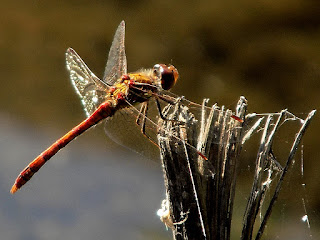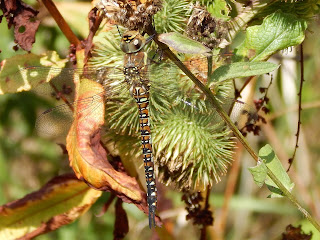One of the hottest days of the year saw me heading over to Priors Hall for a day of dragonfly watching. Conditions clearly suited them as I managed to find a total of fourteen species split evenly between dragons and damsels.
 |
| Ruddy Darter and Emperor. |
While Migrant Hawker numbers are gradually building up they're still quite scarce with most still feeding away from the water. Brown Hawkers on the other hand were seen at most of the ponds and ovipositing was noted at nearly all of them. A couple of male Southerns were also seen patrolling over the ponds. Up to five Emperors were still on site with at least two at the quarry lake. Ruddy Darter was the commonest species followed closely by Common and there were also a couple of latish Four-spotted Chasers.
 |
| Four-spotted Chaser and Brown Hawker. |
Highlight amongst the damsels was a male Willow Emerald close to the spot where Alan found one last year. I'd been hanging around a pond hoping to get a pic of one of the Four-spots when it landed on a grass stem next to me. It stayed in the same area for at least another ten minutes and I ended up leaving it to continue its hunting. Willows seem to have an almost darter type hunting strategy as they seem to select a suitable spot from where to launch sallies out after prey. This one also spent quite a lot of time chasing Ruddy Darters from its chosen territory. It may well be worth checking any potential sites out for them now as they been found at three different locations in the last couple of days.
 |
| Willow Emerald. |
Of the other damsels seen today Emeralds were perhaps the best, they were noted at many of the ponds. It seems as if numbers of Common Blues are bouncing back a bit particularly at the quarry lake where many were seen. Red and Small Red-eyeds were also noted here with several ovipositing pairs of the latter seen. Several Blue-tailed were also found and two Banded Demoiselles had wandered over from the stream.
 |
| Emerald and Small Red-eyed Damselflies. |
Perhaps the best wildlife highlight of the entire day was a Cetti's Warbler singing from the margins of the largest pond. This is my first one in the Corby area, they remain a scarce species in the county away from the Nene Valley. A Brown Hare was the only other non insect sighting of interest.
 |
| Small White and Common Blue. |
Butterflies were surprisingly thin on the ground and air with Small Heath and Common Blue the most numerous after Small White. A few Gatekeepers were still active and there were also sightings of Red Admiral, Painted Lady, Peacock, Small Tortoiseshell, G - V White, Meadow Brown and Speckled Wood.




















































